Richard Tubb's Blog, page 42
November 29, 2021
TubbTalk 99: The Top Ways to Move Your MSP business to a Cybersecurity Focus
Jennifer Bleam runs MSP Sales Revolution. She works with a small number of MSPs to help them scale the  cybersecurity mountain.
cybersecurity mountain.
She helps them with pricing, packaging and a go-to market strategy. This includes sales and marketing, time management and financials.
Why Using a Framework Makes it Easier to Talk Cybersecurity with ClientsThere are so many tools out there that it’s hard to explain them to your clients. MSP owners can’t talk about AI or algorithms. Clients only care about the results they get from using a tool. And being cybersecurity safe.
Jennifer encourages her coaching clients to use a framework to explain the importance of cybersecurity. Both the UK’s NCSC (National Cyber Security Centre) and the US version – NIST (National Institute of Science and Technology set out a framework.
So, when you talk to a client, make it clear that the government requires them to be compliant with the framework. In order to do that, they need your help. This gives you credibility and overcomes objections. You’re selling something that’s a legal requirement for their business.
What does the Cyber Essentials Framework look like? This article explains more, and tells you how to apply.
How Jennifer Helps MSPs Sell Cybersecurity and Close SalesJennifer has developed a ‘secret sauce’ to help her MSP clients close sales. She says that everyone has a sales system, even if it’s not designed as one. Your system is set up to deliver the close rate you regularly hit. If you want a better close rate, then you need to improve the system.
Secondly, we’ve all been told that to be an expert at anything requires 10,000 hours of practice. That’s true if you want to be a world-class violinist in the London Philharmonic. But if you want to play in a local band, studies have found you only need to invest 20 hours. It requires focused time and attention. And the same applies to sales.
The Tool all MSPs Should Have in Their Cybersecurity StackOften MSPs are offering password management to clients as an afterthought. However, Jennifer says it should be top of your list when it comes to cybersecurity. “There’s solid focus on preventing threats getting in. But not so much on when it gets in through other layers of protection.
“You need something in place when things fail, because they will. It’s a cycle: detect, respond, recover, and then you start all over again.” It’s hard for MSPs to admit that tools fail, but you must. No security stack is 100% perfect.
MSP Assumptions That Need ChallengingJennifer says that MSPs often assume their clients wouldn’t buy something because the tool is too expensive. Or they can’t see how it would help them. Don’t make the buying decision for them and think they don’t want what you offer.
Another common misconception is that MSPs think their clients are already aware that cybersecurity is a big deal. So if they want support with it, they’d ask. Most small business owners aren’t. That’s why you need to sell it to them, and use a framework to help.
Jennifer’s Tips for Successful MSP MarketingMany MSP owners say they’re bad at marketing. But the challenge is that somebody has to do it. As the owner, don’t just hire a marketing manager and leave them to find leads. You need to understand marketing basics at least.
It’s fine to outsource what you’re not good at, but know the outcome you want to achieve. Have KPIs and enable the marketing manager to get the right results so you hit your business goals.
Jennifer’s one piece of advice is to select a tactic or strategy and plan to execute on that consistently for a minimum of 6 – 12 months. Results don’t happen overnight. You’ll start to see a change within three months. And a tangible result after six months. By 12 months you’ll see it’s really working.
Using Video and Webinars in Your Marketing StrategyJennifer says video is the tool to use because people love to consume content that way. She explains that there is a difference between videos and webinars: video is evergreen content. It could be a short educational piece to answered a question. Use it at the top of the funnel.
“Webinars are for the middle or bottom of the funnel. People are a little more educated and looking for a solution.” A good way to do a webinar is to get two or three other people in your industry together. Then, talk about a topic that’s important to viewers. They learn and they can ask questions.
How to Connect with Jennifer BleamMSP Sales RevolutionConnect with Jennifer on LinkedInJoin her Facebook GroupWatch her YouTube VideosHow to Connect with MeSubscribe to TubbTalk RSS feedSubscribe, rate and review TubbTalk in iTunesSubscribe, rate and review TubbTalk on Stitcher RadioSubscribe and rate TubbTalk on SpotifyFollow TubbTalk on iHeartRadioFollow @tubblog on TwitterMentioned in This EpisodeEssential EightCIS ControlsNISTNCSCBook: Dan Sullivan: Who Not How: The Formula to Achieve Bigger Goals Through Accelerating Teamwork Book: Keenan: Gap Selling: Getting the Customer to Yes: How Problem-Centric Selling Increases Sales by Changing Everything You Know About Relationships, Overcoming Objections, Closing and Price Free resourcesYou Might Also be Interested inVideo: The Best Cybersecurity Solutions for Today’s SMBsPodcast: How to Accelerate Your MSP Sales for Business GrowthPronto Marketing: Website DevelopmentThe post TubbTalk 99: The Top Ways to Move Your MSP business to a Cybersecurity Focus appeared first on Richard Tubb.



November 22, 2021
TubbTalk 98: Co-Managed IT, CyberSecurity and Imposter Syndrome: Top Tips for MSPs
Vera Tucci is the co-founder and CEO of T-Consulting, an MSP and COMIT. They provide co-managed IT and cybersecurity support  to SMBs without an internal IT department and larger companies looking to improve their teams.
to SMBs without an internal IT department and larger companies looking to improve their teams.
Until she founded the business, she had no technical experience at all. A political science graduate, she met her co-founder and now husband and was captivated by his vision for a tech company.
What a COMIT DoesVera explains that T-Consulting is an MSP and a COMIT – providing co-managed IT and cybersecurity support. Her husband’s idea was for a business that would look after its clients through using an automated tool and charge per month.
They focused on companies without an internal IT department, which was the norm in their local area. Now, they also support larger companies to make their IT team stronger and more secure and to boost overall security.
The Global Dash ProductT-Consulting also has a side business – Global Dash – which started out as an internal product. They wanted to make the company more efficient and identified the tasks that took up too much time.
Checking dashboards, emails and scanning alerts was time-consuming, so the team developed an aggregate platform. It pulls together all the alerts from every tool they use. Everything is in one place, and each technician has their own view.
After running the tool internally for six months and seeing the improvements in efficiency, Vera and Matteo (her husband) decided to present it at an IT event. The feedback from colleagues showed that they should sell it as a separate product.
Vera’s TEDx TalkVera gave a TEDX talk in 2019, sharing the story of her attempt at setting up a side business. The new business was completely different to T-Consulting, and wasn’t a success. Vera took this harder than she’d expected.
In 2018, she had a frank conversation with her Airbnb host in New York. Vera explained what had happened, and the host said: “What you’re going through is hard, but you’ll get through it. And then you’ll share your story to inspire and reassure other women. Failure is a learning experience.”
By chance, Vera came across an ad for TEDx speakers in Italy. She submitted her application, was accepted and told her story onstage. She thought she was doing it to fulfil an ambition, but at the end she was thanked by a young woman. Vera’s talk had resonated with her and taken the shame out of failure.
What is imposter syndrome? This article explains more.
How IT Companies can Keep Clients Safe from Cybersecurity HacksThe key, Vera says, is to never stop educating your clients. MSPs should make that a focal point of their business. Threats are changing daily, and your clients need to understand that.
Your clients aren’t technical people – if they were, they wouldn’t need your help. Keep them in the loop and speak their language. The IT side isn’t important to them, but the consequences of a breach is.
When people don’t understand something, they feel that it doesn’t apply to them. They’re reluctant to ask questions. That’s why you need to make them aware of the risks they face.
What MSPs Shouldn’t do in CybersecurityVera says: “We need to stop selling technology and sell solutions. They don’t need to understand the tool we’ve bought, only how it can help them.” As an MSP, your job is to integrate that tool for your client and keep them safe.
Sometimes we find a solution that’s better than the one we’re already using, and it can be hard to explain to the client why they should switch to the new tool. Explain the benefit of using it, and focus on creating an offer you can sell as a service.
Tools to use and Tools to Avoid in CybersecurityIn her own business, Vera always avoids vendors who proclaim themselves the ‘one tool’ for all your needs. “If they say you need their tool and nothing else, that’s impossible.” There is no one size fits all.
When it comes to cybersecurity, look for a tool that you can easily integrate into your existing offering. You want something that doesn’t require much effort for you to add it in.
How to Connect with Vera TucciT-ConsultingFollow T-Consulting on LinkedInFollow T-Consulting on FacebookFollow T-Consulting on TwitterConnect with Vera on LinkedInHow to Connect with MeSubscribe to TubbTalk RSS feedSubscribe, rate and review TubbTalk in iTunesSubscribe, rate and review TubbTalk on Stitcher RadioSubscribe and rate TubbTalk on SpotifyFollow TubbTalk on iHeartRadioFollow @tubblog on TwitterMentioned in This EpisodeGlobaldashVera’s TEDx Talk: Tears Over Margaritas You Might Also be Interested inFive Questions to Ask When Choosing an IT ProviderPodcast: How do Cybercriminals Think?How to Develop Your ConfidenceThe post TubbTalk 98: Co-Managed IT, CyberSecurity and Imposter Syndrome: Top Tips for MSPs appeared first on Richard Tubb.



November 17, 2021
Powerful Insights from the Future of the MSP and Security Survey
 What is the future of the MSP and Security?
What is the future of the MSP and Security?
That’s the subject of the latest Vanson Bourne report, commissioned by cybersecurity experts, Acronis, and released in conjunction with ChannelPro Magazine.
It’s also the subject of the presentation I’m delivering today in Schaffhausen, Switzerland.
I will be speaking with a room full of Managed Service Providers (MSPs), vendors and industry experts.
However, as not everyone can join us in Switzerland, I thought I’d use this article to give you some of my insights into the findings of the report.
MSPs Speak: Cybersecurity and the future role of the MSP (2H’21)The report MSPs Speak: Cybersecurity and the future role of the MSP (2H’21) highlights the results of a survey conducted by global technology research experts Vanson Bourne in conjunction with ChannelPro Magazine.
The survey respondents include 400+ MSPs, including:-
200 North American-based MSPs100 MSPs based in EMEA50 MSPs in the United Arab Emirates (UAE) and Saudi Arabia50 MSPs in Australia and Singapore.The majority of respondents had 10-99 employees, and 31-75 clients — so representative of the nimble MSPs who read this blog.
I’d encourage you to download the report as it gives some really interesting insights into the way the Managed Services marketplace is currently feeling.
The report is comprehensive, with a lot of information.
Therefore, in this article, I’ll highlight some of the key takeaways I’d like to share from the report.
MSPs are really worried about Cybersecurity The report highlights that 97% of MSPs are concerned about the risk of themselves or clients suffering a cybersecurity breach in the next 12 months.
The report highlights that 97% of MSPs are concerned about the risk of themselves or clients suffering a cybersecurity breach in the next 12 months.
In my experience speaking with MSPs within The Tech Tribe and other communities, I’d say this finding is spot on.
IT businesses are having some very sleepless nights on how to keep their clients safe.
Furthermore, I’d suggest that we aren’t just worried about our clients.
In fact, I would recommend that this is a wake-up call for every MSP to start eating our own dog food.
Why MSPs need to eat their own dog food For example, we shouldn’t just be talking to clients about Multi-Factor Authentication (MFA), Backup and Disaster Recovery (BDR) and Email Security.
For example, we shouldn’t just be talking to clients about Multi-Factor Authentication (MFA), Backup and Disaster Recovery (BDR) and Email Security.
Instead, we need to be actively using these cybersecurity tools within our own businesses!
I can’t tell you the number of MSPs I’ve observed who turn off MFA because it’s “inconvenient” (no, really!).
If we don’t follow cybersecurity best practices internally, how can we expect our clients to take these measures seriously?
Therefore, the “do as I say, no as a I do” mindset is no longer tenable.
As a result, MSPs need to hold themselves to high standards of cybersecurity and highlight the way to our clients.
Almost Half of Clients Don’t Trust MSPs One of the most shocking finding from the report was that 49% of IT businesses admit their clients do not completely trust the security of their MSPs.
One of the most shocking finding from the report was that 49% of IT businesses admit their clients do not completely trust the security of their MSPs.
However, I know from direct experience working with MSPs that they take their clients security incredible seriously.
Therefore, this statistic points to a disconnect between the work MSPs are doing and what clients *think* MSPs are doing.
So, how can we fix this disconnect?
MSPs Need To Overcommunicate With Clients After I sold my MSP business, I did some work as an advisor to West Midlands Police (WMP) in my hometown of Birmingham.
After I sold my MSP business, I did some work as an advisor to West Midlands Police (WMP) in my hometown of Birmingham.
The work I did with WMP included helping them communicate with the general public.
I quickly learned that the Police have a challenge very similar to IT businesses.
The Police, like MSPs, work incredibly hard behind the scenes to keep their clients (you and I, the general public) safe from threats.
However, the only time we ever really contact the Police is when something has gone wrong — a robbery, a theft, or something worse.
Nobody, in history, has ever phoned their local Police force and said “I just called to say thanks! My home has not been broken into today!”
Likewise, no client has ever phoned their MSP and said “Great job, the server hasn’t crashed today!”.
Therefore, the hard work that MSPs do to keep their clients safe isn’t noticed — it’s taken for granted.
It’s my opinion that MSPs need to be overcommunicating the work they do to clients.
On a daily basis, MSPs need to be highlighting the issues they are resolving to keep clients safe.
As a result, clients will understand that their MSPs aren’t just working for them when something goes wrong — the MSP is *always* working for them.
Trust Between Vendors and MSPs is Low Another survey finding that jumped out to me is that 53% of MSPs do not completely trust their vendors.
Another survey finding that jumped out to me is that 53% of MSPs do not completely trust their vendors.
This is shocking, but not altogether surprising.
Given the cybersecurity attacks that vendors like SolarWinds and Kaseya have experienced, I can understand why MSPs are worried.
However, those isolated incidents apart, I believe that the vendor/MSP relationship is broken and needs to change.
As a result, vendors have got to work harder to demonstrate to MSPs that they have their backs.
Vendors — this doesn’t just mean extolling the virtues of the latest new tool you have to sell.
Instead, it means vendors keeping a direct line of communication open with MSPs to help them to keep their clients safe.
Many vendors are already doing a great job of this.
I’d like to see more vendors step up to this challenge.
How MSPs and Vendors Can Work Together MSPs need to improve how they build relationships with vendors too.
MSPs need to improve how they build relationships with vendors too.
As a result, MSPs need to tell their vendors what they need in the way of vendor support to help them increase trust with their clients.
The MSP/Vendor relationship should be one of partnership.
Now — I fully appreciate that this opinion is going to open me to some very strong (OK – hateful!) comments.
Many MSPs have aggressively told me how I’m wrong, and how vendors don’t care about MSPs, and how Venture Capital funding has ruined the channel, and how vendors are driven to make a profit at any cost.
All I can say is this.
My experience working with vendors (both as an MSP owner, and now as an advisor) has not reflected that opinion.
It has been my experience that vendors *do* care about MSPs business, and will listen, if asked.
As my Tech Tribe colleague Nigel Moore says of the MSP/Vendor relationship, “we are all in this together”.
Vendors and MSPs need to come together to mitigate the Cybersecurity threats that small businesses are facing.
As a result, Vendors need to be making MSPs aware of the latest threats.
Plus, MSPs need to be educating their clients to how these threats affect them.
The Future of nimble MSPs is to rely on automationThe Vanson Bourne report highlights that the most nimble MSPs (1-4 staff) are struggling to protect their clients.
As a result of less resources, nimble MSPs are finding it increasingly difficult to defend against cyber attacks including:-
Malware attack via downloadFraudDistributed Denial of Service (DDOS)RansomwareSQL injectionBrute force credentialSupply chain attacksZero day exploits.Having been a nimble MSP owner in a previous life, my advice to smaller MSPs here is this.
If you don’t have the staff to provide protection, utilise more tools.
I’m personally seeing the top nimble MSPs add 4-6 tools per year to help them keep their clients safe.
As a result of these tools, which can automate protection, nimble MSPs are able to lower their cost of support and increase their cybersecurity.
Consolidation of Disaster Recovery and CybersecurityA growing number of MSPs are consolidating their cybersecurity, backup and disaster recovery (BDR) services.
I totally understand why they are doing this.
While you can mitigate against cybercrime with cybersecurity tools, without a disaster recovery (DR) solution, you can never be fully confident of keeping a client safe.
For example, here’s an amazing insight into how one business owner dealt with a ransomware attack.
The article, Hackers tried to rob me of $15m. Here’s how I stopped them… highlights that while in Queensland, Australia were hit with ransomware, CEO Matthew Day was confident of not having to pay the ransom.
Why? Because his business has a strong BDR solution in place that allowed them to roll-back to an immutable version of their data.
As a result, the business experienced downtime, but not catastrophic failure.
The lesson for MSPs here is simple.
Consolidating your Cybersecurity and Disaster Recovery offerings isn’t a nice to have, it’s now essential.
Furthermore, we need to be sharing our knowledge of how cybersecurity attacks are being perpetrated.
As cybersecurity expert Ian Thornton-Trump told me in our conversation about How to Navigate the Scary World of MSP Cybersecurity, “Listen to what’s being talked about, pay attention to how other businesses are getting hurt and don’t let that happen to your businesses.”
The future of the MSP and security is built on open dialogue, transparency and communication.
MSPs struggle to justify rising costs to clientsAnother key element I took from the Vanson Bourne report is that MSPs are struggling to justify cost increases to clients.
Specifically, MSPs are implementing new Cybersecurity measures, but when they approach their clients to increase costs, clients are saying “Don’t we already pay you for this?”
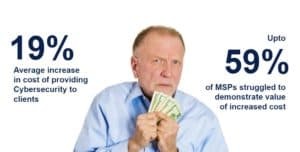
One way to mitigate this challenge is to implement the Good/Better/Best Managed Services style-agreement and then update it regularly.
Nigel Moore (there’s that man again!) excellent book “Price, Package, Profit” explains this concept brilliantly.
What I’m seeing some MSPs do is to educate their clients that these packages are not set in stone.
As a result, each year (at least!) MSPs are increasing the prices of their packages, but offering additional cybersecurity measures to justify the increase.
For example, I know one MSP who name their packages with extensions of 2020, 2021, etc.
Therefore, when they speak to clients about price increases, they are doing so while introducing a “new” package each year.
This tactic enables the MSP to keep to modern cybersecurity standards without having a multitude of clients on differing packages.
Margins are Dropping for MSPsAnother challenge that the Vanson Bourne report highlighted is that most MSPs are struggling with increasing costs eroding their margins.
For example, look at the furore that Microsoft have experienced after increasing their M365 package prices for the first time in year!
The bottom line here is that we all expect price increases in business and life.
When the price of your electricity, gas or broadband rises, you may grumble, but it doesn’t come as a shock.
Therefore, your MSP clients will expect price increases.
As MSPs, you need to be increasing your prices regularly (see the the above section on justifying price increases to clients).
One of the fundamental tenants of Managed Services is to monitor your profitability, NOT your turnover.
If the cost of your tools increases, then pass those costs onto clients — don’t make assumptions about what clients will and won’t agree to pay.
The future of the MSP includes regular price increases, full stop.
The Future of the MSP and Selling Security Services The Vanson Bourne report highlights that the majority of MSPs are using multiple tools from different vendors, often with overlap between the functionality of these tools.
The Vanson Bourne report highlights that the majority of MSPs are using multiple tools from different vendors, often with overlap between the functionality of these tools.
In fact, the MSPs featured in the report work with an average of four vendors for cybersecurity, backup and disaster recovery tools.
Going forward, 92% of MSPs in the survey said they were looking to consolidate their tools.
MSPs can benefit from working with fewer vendors, often utilising a single monitoring interface.
For instance, Acronis coined the term “Cyber Protection”, with an offering that delivers a cybersecurity, backup and DR solution within a single pane of glass.
As a result of working with fewer vendors, MSPs can realise:-
Lower licensing costsReduced training CostsFewer costs in documentation and maintenancePlus, I believe that you will also build a strong relationship with your vendors after consolidation and avoid finger pointing and arguments between vendors if a breach occurs.
The potential downside to consolidation is a risk of “all your eggs in one basket”.
However, I broadly agree with the reports findings that consolidation brings more benefits than it does weaknesses.
Consolidation Brings Automation Benefits Earlier, I mentioned the fact that nimble MSPs can benefit from utilising automated tools to keep their cybersecurity offering sharp.
Earlier, I mentioned the fact that nimble MSPs can benefit from utilising automated tools to keep their cybersecurity offering sharp.
The Vanson Bourne report highlights that those MSPs have have consolidated their tools have also benefitted from increased automation.
As a result, when it comes to recovering from a cybersecurity breach or data loss incident, those MSPs who have automated have saved an average of 5 hours in recovery time.
That is impressive — especially given that the first question any client asks when they are notified of a breach is “How quickly can we be back up and running?”
The lesson here is clear — the future of the MSP and security needs to incorporate strong automation.
Automation, Automation, AutomationWhen it comes to automation, however, the challenge for MSPs is that not all vendors place nicely together.
API connectivity is still a challenge, and many tools do not interface effectively.
The takeaway for MSPs here is that if you are considering working with multiple vendors, understand the integration between their tools *and* the potential political divides between the vendor providers.
I’ve seen many an integration between vendor tools working one day, and then broken the next — with the vendors involved pointing fingers at one another for the failing.
Again, though, for nimble MSPs who might struggle to hire and retain great staff, automation is key.
The Future of the MSP – Artificial Intelligence A final point on the automation front.
A final point on the automation front.
From my advisory work with a number of vendors, I can tell you that vendors are heavily investing in artificial intelligence (AI) and machine learning (ML).
AI/ML isn’t a future technology — it’s here now, and the automation AI brings is saving many MSPs man hours.
As a result, the future of the MSP is AI.
Therefore, when it comes to consolidating vendors, a simple question your MSP can ask vendors is “What’s your AI strategy?”.
The vendors answer will let you know whether they are thinking to the future, or stuck in a maintenance mindset.
ConclusionWhen it comes to the future of the Managed Service Provider (MSP) and security, the Vanson Bourne report MSPs Speak: Cybersecurity and the future role of the MSP (2H’21) is a fascinating insight into how modern MSPs from across the world are thinking.
Cybersecurity, not surprisingly, is top of mind and MSPs have work to do in building trust with their clients.
However, vendors also need to work on their relationship with MSPs.
The Cybersecurity issue isn’t one that will be resolved in isolation — it will take the channel coming together to help defeat the cybercriminals.
If I were to summarise my key three takeaways from this report, they would be:-
Overcommunicate with your clients (and talk to your vendors more!)Brand your Managed Service/Security packages and update them regularlyConsider consolidating the vendor tools you useHowever, I’d encourage you to download the Vanson Bourne report and come to your own conclusions.
What did you takeaway from the report?
As a result of the report, what changes are you looking to make in your IT solution provider or Managed Service Provider business?
Let me know in the comments below, or get in touch.
You Might Also Be Interested InHow Do Criminals Think? CyberSecurity for MSPsHow MSPs Can Adapt To Emerging CyberSecurity Threats for Better Client SupportCyber Security Top Tips for Small Business Success and GrowthThe post Powerful Insights from the Future of the MSP and Security Survey appeared first on Richard Tubb.



November 15, 2021
TubbTalk 97: How to Effectively use Email Security to Keep Your MSP Clients Safe
 Olesia Klevchuk is the Principal Product Marketing Manager for Email Security at Barracuda Networks. Barracuda
Olesia Klevchuk is the Principal Product Marketing Manager for Email Security at Barracuda Networks. Barracuda  are a cybersecurity company. They provide security solutions for organisations all over the world.
are a cybersecurity company. They provide security solutions for organisations all over the world.
And they offer email, network and application security as well as data protection. In addition, they’re the partner of choice for businesses from North America, Asia and Europe. So, they’re ideal for anyone who needs to take security seriously.
Barracuda’s Email SecurityA lot of threats come through email, says Olesia. Phishing attacks are at the top of most data breaches. Everyone receives so many emails on a daily basis. Hackers have found the weakest spot to get into a network.
They’ve developed ways to bypass traditional email security solutions. And this is why Barracuda have focused on developing new ways to protect their clients. So, they use AI and machine learning to find ways to deter the hackers.
Where Cybercriminals Focus to Exploit Email Security VulnerabilitiesIn recent years, hackers have focused on social engineering tactics. These are much more successful. And they carefully craft emails that look genuine. Most importantly, to block them requires a sophisticated tool.
AI and machine learning recognise patterns of communication within the organisation and then identifies anomalous emails. But, Olesia says, detection isn’t enough, because one day the email gets through. Then, you need a quick response to the attack.
Email Security TrendsEmail threats are increasing in complexity and succeeding quite a lot of times. Hackers have moved from spam and malware to emails that look genuine. They no longer rely on a spray and pray approach – they target an individual.
They’re organised and have a lot of resources at their disposal. They research their targets carefully, says Olesia. And, the focus is no long getting inside and causing havoc – the hackers want money, and usually a lot of money.
How to Help MSPs Detect ThreatsThreats are harder to detect than they were before. And Olesia says Barracuda spots around 97% or attacks before they happen.
Some technologies are incredibly accurate at detecting high-volume attacks from a bad IP or with a malicious payload.
So the personalised emails are harder to spot, because hackers are sending them from genuine Gmail accounts with no link or attachment.
Therefore, the email isn’t flagged as malicious. As a result the hacker uses it to gain access to a network.
The Mistakes MSPs Make with Keeping Their Clients SafeIt’s important to remember that what used to keep your clients safe might not work anymore. Don’t just stop at threat prevention; prepare for the 1% that get through. You need a gateway, but you also need to educate your clients on staying safe.
Have a security awareness programme in place, and help clients to be proactive about reporting suspicious emails. And, have a security plan in place with a data backup and restore process if the worst happens. Minimise the damage.
How to Protect Clients Against RansomwareRansomware attacks have been devastating over the past 12 months because they’ve grown in complexity. Furthermore, the criminals aren’t just asking for $1,000; they’re asking for millions.
Hackers know that emails are scanned for links, attachments and other things that look suspicious. So, they now ask the victim for their credentials. And they use a multi-step approach to gain access to the organisation.
The first step for MSPs is to make sure the emails are protected, and then to secure applications. Many SMBs use Office 365. However, this is vulnerable. Because M365 only backs up data for 30 days. And then you have no protection. So a third-party solution like Barracuda’s is recommended.
Why Olesia Chose a Career in TechTechnology is always changing, says Olesia. So it’s never boring. “And there’s always something new to learn, to do. It’s all around us. And I believe that everyone needs some form of security.
“Because hackers aren’t going anywhere; they’re just getting smarter. And the use of machine learning is fascinating. So the space is evolving around us. As a result, there’s a lot to do. And being in security feels like you’re fighting the bad guys.”
How to Connect with Olesia KlevchukBarracudaConnect with Olesia on LinkedInHow to Connect with MeSubscribe to TubbTalk RSS feedSubscribe, rate and review TubbTalk in iTunesSubscribe, rate and review TubbTalk on Stitcher RadioSubscribe and rate TubbTalk on SpotifyFollow TubbTalk on iHeartRadioFollow @tubblog on TwitterMentioned in This Episodee-book: 13 Threat Types to Know Right NowWebinars: https://barracudamsp.com/msp-resources/on-demand/Blogs: https://smartermsp.com/Free month of Barracuda SolutionsYou Might Also be Interested inHave I Been Pwned?Podcast: How to Navigate the Scary World of MSP SecurityExpress VPN
The post TubbTalk 97: How to Effectively use Email Security to Keep Your MSP Clients Safe appeared first on Richard Tubb.



November 8, 2021
TubbTalk 96: Struggle: The Surprising Truth, Beauty and Opportunity Hidden in Life
 An Interview with Grace Marshall
An Interview with Grace Marshall
In this episode, Richard talks to Grace Marshall, Productivity Ninja and award-winning author of four books, including the best-selling “How to be Really Productive”. They chat about productivity and her new book, “Struggle.”
She describes herself as naturally disorganised, but managed to start her business while raising two children. Her clients kept asking how she did it, so she decided to share her advice with them.
Grace explains that she had the idea for her new book, “Struggle: The Surprising Truth, Beauty and Opportunity Hidden in Life’s Shittier Moments”, three years ago.
“We often think of productivity as efficiency, about speed and getting things done. Of course it is, but we can see struggle as an obstacle. We’re failing somehow. We all struggle but it’s taboo, and I wanted to challenge that”.
She describes the book as a cross between self-help and business. It’s very personal but it’s also practical. “You can use it to make you feel better and see things differently when you’re middle of a crisis.”
**please note, this interview contains several uses of a mild profanity**
Why People Struggle to Get Things DoneProcrastination is a very human thing. We want to avoid things that are boring and scary, Grace says. “When we notice ourselves procrastinating, we can accept it as normal. And that takes the pressure off.”
Worrying about something hard takes up a lot of headspace and weighs us down. We need to be curious rather than fearful. How can we break it down? How can we accept that it’s new and scary but not bad? You’re stretching yourself and growing.
Sometimes when we feel like we’re procrastinating, or we’re struggling with something, and we think, ah, does that mean that I’m in the wrong place? Does that mean I’m not sure that I shouldn’t be doing this at all? Actually, the opposite is true.
How to Take a Step Back From StruggleGrace describes three steps you have to take to shift your thinking. The first is to recognise you’re struggling. Something is hard and you’re trying to fix it.
Our primitive, ‘lizard brains’ try to protect us from threats by encouraging procrastination. We think in fight or flight mode – push through (fight) or avoid it (flight).
Next, get curious and start asking questions. This is a brilliant antidote to fear. What is the problem you’re having – what do you think it is? Could it be something else – an opportunity rather than an obstacle?
Finally, stop looking for certainties. Move away from black and white thinking and look wider. What could your challenges mean for you that would be positive instead of negative? This lets us be more creative and innovative.
How to Recognise StressWhen you’re feeling fearful, it’s easy to mistake that for an attack. Grace says that learning to notice those feelings will help you realise you’re stressed. You can change how you respond to feelings of panic and uncertainty.
When we change our perception of what’s going on and how we feel, we change how we experience it. We change what we do in response. And we can start to recognise stress in others. That allows us to be compassionate and support them too.
The Fast Brain vs the Slow BrainThe idea of the fast and slow brains comes from Daniel Kahneman’s book Thinking Fast and Slow. He calls them system one (fast brain) and system two (slow brain). Fast brain looks for patterns and jumps to conclusions. That’s how we’re efficient and productive.
System two is our slower brain. It’s more considered, takes data into account and takes time to figure things out. It uses a lot more resources, but it tends to be more accurate.
So when it comes to productivity and business building, when we do the things we know well, we use our fast brain quite well. But when we’re dealing with something new, we need to take our time and look deeper, we need to use our slow brain.
Why High Achievers put too Much Pressure on ThemselvesSometimes we can use productivity to beat ourselves up. Which is probably the least productive thing we can do! High achievers sometimes put a lot of their identity in achieving. They don’t know who they are if they’re not doing well.
We don’t allow ourselves grounds to not be the expert. We don’t allow ourselves that space to learn something new. And, we fear not having the answers, but we need leaders to be willing to say they don’t know. And then finding out alongside their teams.
The Importance of Rest and Rhythm to Deal with the StruggleGrace uses the term ‘work/life rhythm’ rather than ‘work/life balance.’ “Balance always feels like accounting, and if one is balanced the other isn’t. But rhythm is like a dance. There’s a mix of fast and slow.”
Work never ends, so you have to put in your own finish lines. Technology enables us to be 24/7, but human beings can’t really do that. Recognise that you’re at your best when you’re rested. Don’t just keep pushing through.
It’s not sustainable and it doesn’t help you to do your best work. You’ll end up ground down and can’t see the bigger picture. Taking time to rest means you come back with more brain power and capacity for work. Otherwise, you can do more damage than good.
How to Connect with Grace MarshallGrace Marshall’s WebsiteFollow Grace on TwitterFollow Grace on FacebookConnect with Grace on LinkedInHow to connect with MeSubscribe to TubbTalk RSS feedSubscribe, rate and review TubbTalk in iTunesSubscribe, rate and review TubbTalk on Stitcher RadioSubscribe and rate TubbTalk on SpotifyFollow TubbTalk on iHeartRadioFollow @tubblog on TwitterMentioned in This EpisodeGrace’s new book and websiteGrace Marshall: 21 Ways to Manage the Stuff that Sucks Up Your Time Grace Marshall: How To Be REALLY Productive ePub eBook (Brilliant Business) Richard Tubb: The IT Business Owner's Survival Guide: How to save time, avoid stress and build a successful IT business Daniel Kahneman: Thinking, Fast and Slow David Allen: Getting Things Done: The Art of Stress-free Productivity Graham Allcott: How to be a Productivity Ninja UPDATED EDITION: Worry Less, Achieve More and Love What You Do Think ProductiveYou Might Also be Interested inPodcast: Productivity, Healthy Habits and Getting Stuff DoneThe Productivity PlannerWelltory: Manage Your Stress and EnergyThe post TubbTalk 96: Struggle: The Surprising Truth, Beauty and Opportunity Hidden in Life appeared first on Richard Tubb.



November 3, 2021
Kaseya Connect IT Europe 2021 – I’m Too Busy To Be Stressed!
 How does stress affect you? I think it’s fair to say that the past 18-months have been challenging times for the owners of IT Managed Service Provider (MSP) businesses.
How does stress affect you? I think it’s fair to say that the past 18-months have been challenging times for the owners of IT Managed Service Provider (MSP) businesses.
Many MSP owners are feeling tired, stressed, but too busy to work out how to make the time for self-care.
Which is why I wanted to give you a heads-up that I’ll be delivering a very special presentation at the Kaseya Connect IT Europe 2021 event, taking place virtually on 16th and 17th November 2021.
The title of my presentation is Too Busy To Be Stressed. How to Avoid Being Overwhelmed as an IT Business Owner.
I’m Too Busy To Be StressedIf you’re feeling the strain at the moment, but not sure how to make the changes that will help you get out from under, then my session is for you.
As a result of being a former MSP owner, I know all too well the pressures that running an IT business can bring.
That’s why “Too Busy To Be Stressed” will help you with practical tips and techniques to help you get out from under.
At the end of this session, you will come away feeling positive about how to reduce your stress, run a successful MSP business and avoid being overwhelmed by the challenges put in front of you.
Kaseya Connect IT Europe 2021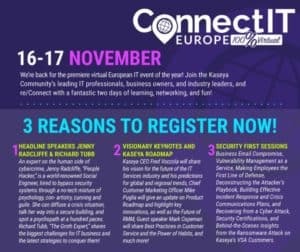 My presentation will be part of a two-day virtual event from Kaseya.
My presentation will be part of a two-day virtual event from Kaseya.
But I’m not the only speaker you can hear from!
Kaseya Connect IT Europe has become one of the premier events on the IT conference calendar.
As a result, you will experience a fantastic two days of learning, networking, and fun- from the comfort of your own home!
Sessions at Kaseya Connect IT Europe this year include:-
Ronan Kirby – President and General Manager, EMEA, IT GlueFred Voccola – CEO, Kaseya, with his vision for the future of the IT Service IndustryGary Pica – The MSP Legend talks about the evolving role of the VCIO (Virtual Chief Information Officer)Jenny Radcliffe – “People Hacker”, talking about the human-side of CybercrimeSecondly, there will be a whole range of sessions focused on Cybersecurity, which include a behind-the-scenes insight into the ransomware attack on Kaseya’s VSA clients.
Get Your Swag! If you’re worried about missing the swag that you’d normally find at an IT conference, never fear!
If you’re worried about missing the swag that you’d normally find at an IT conference, never fear!
Therefore, Kaseya have arranged for a premium swag box to be delivered to your door!
Moreover, you will experience over over twenty vendor booths and a chance to win an electric bike.
How to Register for Kaseya Connect IT Europe 2021Kaseya Connect IT Europe 2021 takes place virtually, on November 16th and 17th 2021.
Click here for more details and to register.
See You At Kaseya Connect IT Europe 2021The past 18 months have been busy, stressful, but also a time of growth for IT businesses.
Therefore, make sure to use this opportunity to slow down, take stock and reward yourself for everything you’ve given.
Register for Kaseya Connect IT Europe and surround yourself with some of the top people in the industry.
Do you have any questions about mental health, stress management or any aspect of running an MSP business?
Then, please leave a comment below or get in touch. I’ll be featuring your questions in my presentation.
You Might Also be Interested inMental Health Resources for MSP Business OwnersTubbTalk #65 – Mental Health for MSP OwnersMindDoc: Your Mental Health CompanionThe post Kaseya Connect IT Europe 2021 – I’m Too Busy To Be Stressed! appeared first on Richard Tubb.



November 1, 2021
TubbTalk 95: How the Government is Helping Women get Ahead in Technology
 An Interview with Baroness Elizabeth Berridge
An Interview with Baroness Elizabeth Berridge
In this interview, Richard speaks to Baroness Elizabeth Berridge about women in technology.
Baroness Berridge is Minister for Women and Equalities for the UK. It’s within the Department for International Trade. She’s also a Minister in the Department for Education.
How to Encourage More Women to Join the Technology IndustryFor instance, if more women founded businesses, it would add around £250bn to the economy. “And adding women to men-only boards improves productivity.”
So, employers need to make their roles more attractive to women. And they need to encourage a diversity of backgrounds and experiences.
Research has looked at behavioural insights for job vacancies. And it found that advertising flexible working led to more female applicants.
As a result, employers should take into account the differing needs of potential hires, too.
How to Eliminate the Perception That STEM is Only for Boys“I don’t know where that comes from,” Baroness Berridge says. “Because every young person has a smartphone. So why wouldn’t they want to know about the coding and developing behind it?”
And, she’s also actively involved with the Diversity Champions Network. This promotes apprenticeships, particularly to girls. And this has led to an increase of around a third in the number of girls taking STEM subjects.
Therefore, the key is to overcome this notion that girls can’t do maths. So, the government is developing specialist sixth form colleges.
These will offer STEM, further maths and similar subjects. And they’re also specifically tasked with outreach to female pupils.
How Apprenticeships can Encourage Young Women into TechnologySo the government has newly introduced Skills and Post-19 Education Bill. It’s designed to build on apprenticeships. And it places the employers at the heart of developing the new training and qualifications.
Doing an apprenticeship and having technical qualifications is different to traditional A levels and university. So we We need young people to understand that. But they’re both equally valid.
So from 2025, there will also be new legislation on student loans. And everyone will be eligible to four years’ entitlement, which will last a lifetime. And they can be used across sectors, qualification type and level. So they’re designed to be flexible for people’s requirements.
The Opportunities for Women in Technology to ‘Build Back Better’The government’s ‘Build Back Better’ Plan is about recovery from the Covid pandemic. Firstly, it includes adapting to flexible working and the cultural change. Secondly, it’s a good way to get more women into the workforce.
However, Baroness Berridge says it’s also important to focus on the net zero agenda. And this means embracing green technology. “In my role at the Department of Education I’m in charge of the capital spends for school buildings.
“We look at how to build new buildings in a way that are on net zero.” These things are important to young people, and women in technology can help make them happen.
How an African Proverb has Impacted Baroness Berridge’s LifeBaroness Berridge’s favourite proverb is: “If you want to go fast, go alone. but if you want to go far go together.”
“Above all, I’ve needed people beside me to give advice and support. During the early days in my career as a barrister and now.
“We all need each other. And it’s not just about encouragement. So, you need people on side to tell you when you’re getting it wrong.
“I think I’ve avoid many pitfalls and mistakes. Because people are prepared to tell me the hard truth. So you need people to help you go further. But you also need to be open. And to listen that constructive criticism along the way.”
The Changes Baroness Berridge Would Like to See for Young Women in TechnologySo in her time as Minister for Women and Equalities, Baroness Berridge has met some inspirational young women. For instance, they’ve set up businesses or started apprenticeships. “I’m seeing more of a parity of esteem. And I want that to continue.
“Many young women from the ‘left-behind areas’ want better futures for themselves. And they’re working hard to make that happen. So, I want them to inspire each other. It’s an exciting time for women to get ahead. And technology plays a big part in that.”
How to Connect with Baroness BerridgeDepartment for International TradeBaroness Berridge’s websiteFollow Baroness Berridge on TwitterHow to Connect with MeSubscribe to TubbTalk RSS feedSubscribe, rate and review TubbTalk in iTunesSubscribe, rate and review TubbTalk on Stitcher RadioSubscribe and rate TubbTalk on SpotifyFollow TubbTalk on iHeartRadioFollow @tubblog on TwitterMentioned in This EpisodeDiversity Champions NetworkSkills and Post-19 Education BillHome Office Violence Against Women and Girls StrategyBuild Back BetterYou Might Also be Interested InPodcast: Being a Woman in a Male-Dominated IndustryCelebrating Five Amazing Women in TechPodcast: Advancing Women in ITThe post TubbTalk 95: How the Government is Helping Women get Ahead in Technology appeared first on Richard Tubb.



October 18, 2021
The Power of Help Through Your Local MSP Peer Groups
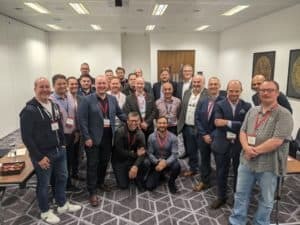 Tech Tribers at a Tribal Gathering during the CompTIA EMEA Conference
Tech Tribers at a Tribal Gathering during the CompTIA EMEA ConferenceIs there any other industry like the Managed Service Provider (MSP) space for offering help via local MSP peer groups?
I’ve been a part of the Managed Service Provider (MSP) industry for almost 15+ years now.
I often share with people from other industries the fact that MSPs get together at conferences, and at user and peer groups, to help one another.
People think I’m crazy! “Why would competitors help one another like that?” they ask.
The answer is that the MSP industry is a uniquely supportive space. The old adage “A rising tide lifts all boats” comes to my mind.
However, over the past few years, and thanks, in part, to the pandemic, the once-thriving MSP peer groups have all but died out.
But… we have a plan to reboot them!
Local MSP Peer Groups – Then A photo from the AMITPRO group in Birmingham, circa 2012
A photo from the AMITPRO group in Birmingham, circa 2012When I ran my MSP business, one of the huge factors in accelerating my businesses growth was regular attendance at peer group meetings.
Being Birmingham-based, my local MSP group was called AMITPRO – The Association of Midlands IT Professionals.
The AMITPRO group used to meet monthly at The Arden Hotel in Solihull, where, typically, 20+ MSP owners would exchange best practices, ideas and challenges.
This wasn’t a networking group (although we did network!).
Instead, AMITPRO was closer to the concept of a mastermind group, with members helping one another to solve problems and exchange ideas.
As I wrote in my blog post 3 Good Reasons to attend your local User Group Meeting, why re-invent the wheel?
You can accelerate your growth by learning from others who have been there and done that.
There were groups similar to AMITPRO up and down the UK, and, indeed, in Australia, North America and other parts of the world.
Many of these groups were born out of user groups focused on Microsoft Small Business Server (SBS) — or the Microsoft Small Business Specialist (SBSC) comminuty, as it was known.
Sadly, with the death of Microsoft Small Business Server, these groups also slowly died away.
Some UK groups did remain (notably, the London group, the North West England group, and the Thames Valley group) but when the COVID-19 pandemic hit, they pretty much died too.

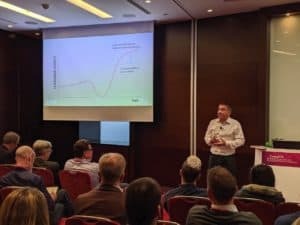 MSP Industry expert Mark Copeman presenting at a CompTIA event
MSP Industry expert Mark Copeman presenting at a CompTIA eventFast forward to the present day, and while there are a variety of user groups (you can check out A List of User Groups for UK Managed Service Providers) they often meet irregularly or virtually.
Here in the UK, industry groups such as CompTIA organise the CompTIA UK Business Technology Community, The Benelux Technology Community and other communities. These communities used to meet, in-person, quarterly. We hope they will resume that practice, post-pandemic.
But the concept of local, regularly meeting, MSP-focused peer groups has all but died.
This has left a huge gap in the MSP community.
So, we now want to fill that gap.
Rebooting the UK Peer Group Communities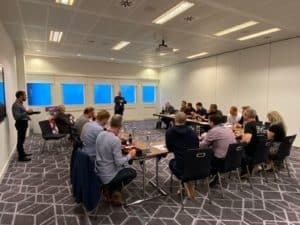 I mentioned that my MSP business was accelerated thanks to the help of my peers.
I mentioned that my MSP business was accelerated thanks to the help of my peers.
I’m not alone in this respect, as the illustrious leader of The Tech Tribe, Nigel Moore, built his Syndey-based MSP based off the support of the local MSP community.
When Nigel asked me to work with him within The Tech Tribe, one of the earliest conversations we had was around rebooting the local MSP Peer Group community.
Sadly, the COVID-19 pandemic happened, and plans were put on hold.
However, in September 2021 we kicked off a pilot scheme to reboot the UK’s peer groups.
North-East England (Newcastle-upon-Tyne)StaffordshireDublinNorth-West England (Manchester)In November 2021, we will be adding groups in:-
LondonEdinburghEast Anglia (Cambridge)We have also had expression of interest from groups in Thames Valley (Reading), South Wales (Cardiff), North Wales, Leeds, Birmingham, Southampton and even Italy!
We’ve put together a page where you can see all the details of the Tech Tribe Local Tribal Gatherings.
Clearly, there is a desire for groups of MSPs to get together in-person again!
So what will these new groups look like?

 The Tech Tribe North West England Local Tribal Gathering in Manchester
The Tech Tribe North West England Local Tribal Gathering in ManchesterFirstly, while we’re putting the Tech Tribe branding behind these groups — this isn’t a Tech Tribe initative.
This is an MSP community initiative.
You can attend the meetings whether you are a Tech Triber or not. This initiative isn’t meant as a way of boosting Tech Tribe membership.
Attendance is free of charge.
The Local Tribal Gatherings will be only to all Managed Service Providers (MSPs), Value Added Resellers (VARs), IT Consultants, Cloud Solution Provider (CSPs) and anyone else who is involved in the business of IT Support and Consultancy.
Plus, the Tribal Gatherings will be open to vendors and industry experts.
Are Vendors Welcome?When we mention vendors and community group meetings, many folks become a little squeamish!
It’s true that the old community groups become vendor pitch-fests, dominated by vendors trying to sell their wares.
However, the Tech Tribe is a vendor-neutral meeting place.
Vendors are welcome to come and add their voice to the conversation, both in the Tribal online forums, and at the Tribal Local Gatherings.
However, there is a strict “no pitch” policy for vendor involvement.

Both Nigel and I strongly believe that vendors are part of the MSP community ecosystem. Vendors need to be involved in the conversation.
Those vendors who “get it”, will realise that by adding value to the communities, they will attract new business.
One such vendor is Pax8, who have kindly agreed to sponsor the UK Tribal Local Gatherings, ensuring that room hire and refreshments are covered.
So, if you attend a Tribal Local Gathering, what will it look like?

While each group will have its own particular flavour, broadly speaking you can expect:-
A monthly (or quarterly for some groups, depending on demand) local meeting, typically from 6-9pm GMT.Your group lead to give a 5-10 minute industry news updateAn hour round-table discussion on the topic of the month (as voted for by the members).A refreshment break (did someone say Pizza?)An hour round-table open round-table discussion where you can ask for help and give helpMany groups then continue the conversation at a local pub or restaurant. 
Some of the topics we’ve already discussed at Tribal Local Gatherings include:-
Mergers / AcquisitionsPeople / Hiring / StaffService DeliveryWorking with Virtual AssistantsOutsourcing… and many more.
The groups drive the discussion topics, so feel free to talk about what interests you.
Will there be a Local MSP Peer Group near to me?While we’re rolling this pilot scheme out in the UK, we expect to move quickly with Tech Tribe Local Gatherings in the USA, Canada, Europe and Australia.
If you’d like to be involved in a group near to you, check out the list of Tech Tribal Local Tribal Gatherings, and reach out directly to the group leader.
However, if you don’t see a group local to you, but are interested in attending or leading a group, please contact me.
If you’re already a Tech Triber, then you can also find out more details and register your interest in the Tech Tribe Forums.
Remember, the Tribal Local Gatherings are open to anybody in the MSP industry, and you don’t need to be a Tech Triber to attend.

Running an IT business can be a lonely task.
Thankfully, the Managed Service Provider industry is fairly unique in that it is very common for peers to help one another.
The benefits of attending a local peer group are that you can accelerate your businesses growth.
You can learn from others, exchange ideas, and build relationships that will pay dividends for years to come.
Prior to selling our MSP businesses, both Nigel Moore of The Tech Tribe and myself built our companies, in a large part, due to peer communities.
This is why we’re building a network of Tech Tribe Local Tribal Gatherings.
The Tribal Local Gatherings will be monthly meetups for MSPs to get to know, and learn from one another.
And finally, if you’re skeptical of competitors helping one another, then get yourself to a Tribal Local Gathering and sit quietly.
However, be prepared to have your eyes opened to a world of peer collaboration. 
Have you attended an local MSP Peer group before? Would you be interested in getting involved? Leave a comment below or get in touch.

The post The Power of Help Through Your Local MSP Peer Groups appeared first on Richard Tubb.



TubbTalk 94: How to do Password Management, MFA and Security Right in Your MSP
In this interview, Richard speaks to Chris Tate, global strategic alliance director at MYKI. The company offers a  two-factor authentication and password management solution specifically designed for MSPs, MSSPs and VARs.
two-factor authentication and password management solution specifically designed for MSPs, MSSPs and VARs.
Chris worked in multiple MSP businesses as a service manager, a technical director, and a Director of Product Strategy. He also founded the Totally MSP website and worked as the former Business Development Director at Datto.
He’s also a long-time member of CompTIA, the UK channel community, and currently serves on the Executive Council. In 2020, he was the CompTIA UK Spotlight award winner.
Watch the Video InterviewHow the MYKI Password Management Tool WorksChris explains that many password managers leverage cloud storage and use a master password to decrypt the vault. The passwords can be used on multiple devices because they live in the cloud.
MYKI is different – the passwords live on your devices and only your devices. If you have an iPad, phone and laptop, your passwords exist only on those devices and are synchronised between them.
If you change a password on your PC, the next time you turn your iPad on, it will look to see what’s changed, and then send the password down totally encrypted.
There’s no way anyone can hack into the MYKI servers and get access to the passwords, because they don’t exist.
You can use MYKI on Windows, MacOS and Linux, and on mobile iOS and Android. It works on Safari, Chrome, Firefox and Edge as well.
The Consequences of Bad Password ManagementIt’s understandable that people use the same password, because they’re difficult to remember, says Chris. “In an ideal world, we won’t have passwords. But for now, any password manager and security solution are the trade-off between convenience and security.”
To help your clients, Chris says to ensure that people use unique passwords for every application and service. “You’re only as secure as your weakest password.” If you create a really strong password but use it on all platforms, that’s not a good idea. Facebook has good security, but many apps are frequently breached.
This leads to ‘credential stuffing’, where your username and password are used on every major site by cybercriminals. The criminals then sell the passwords on. Password management tools make this impossible.
How MSPs can Deploy MYKI to Multiple Client SitesDeployment is as easy as possible, says Chris, with tools to help MSPs do it on behalf of the end users. MYKI offer support too, to improve the onboarding experience.
They also provide videos to help the users get started. “It’s gamified to encourage them to get their passwords set. And we can look at the metadata to see how high or low their security score is.”
People start to use MYKI out of necessity, Chris adds, and if they use it personally too, they really begin to see the benefits. They’re more likely to embrace it for work that way.
Why MSPs Should use a Password Management ToolChris says that when it comes to password management, MYKI’s competition is not another tool but no password manager at all. They try to educate MSPs, SMBs and end users that they should use some sort of password manager, no matter which one.
Some people use their PSA (professional services automation) tool to save passwords, or an Excel spreadsheet. However, these aren’t the best options – move with the times and use something more efficient.
And, MSPs are now the target cybercriminals. It’s easier to go to them first, because the MSPs have access to a lot of other companies’ data. If you’re not using a password management tool, Chris urges you to find one soon.
MFA Password Management with MYKIMYKI makes 2FA (two factor authentication) and MFA really simple. When you visit a site, log in and authenticate with their app. It will then insert the 2FA as well, which is good for businesses.
It allows people to share passwords and MFAs without having to tell colleagues their details. MYKI lets you share both with anyone in your support team as soon as they use the app. You don’t need access to people’s smartphones to do it.
Not sure what MFA (multi-factor authentication) is? This article might help.
Guard by MYKIGuard by MYKI is a browser security solution. It’s built exclusively for MSPs to manage clients’ browser security. You can install an ad blocker on their behalf, for instance.
Chris says Guard does it quicker because you can centralise and do it all from one console. You can also track everything each month and then generate a report. This shows how you’re protecting them from phishing and other hacking attempts.
Guard also tries to educate users with timely information. If they start to enter credit card details, it will pop up to check that’s what they want to do. Likewise, it will flag HTTP sites and phishing websites masquerading as genuine sites.
How to Connect with Chris TateMYKIConnect with Chris on LinkedInFollow MYKI on TwitterFollow MYKI on FacebookHow to connect with MeSubscribe to TubbTalk RSS feedSubscribe, rate and review TubbTalk in iTunesSubscribe, rate and review TubbTalk on Stitcher RadioSubscribe and rate TubbTalk on SpotifyFollow TubbTalk on iHeartRadioFollow @tubblog on TwitterMentioned in This EpisodeDattoConLast PassKeePassN-able RMMGoogle Authenticator: Android and iOSAuthyMYKI resourcesGuard by MYKIMYKI Password GeneratorMYKI Hack CheckCompTIAThe Tech TribeYou Might Also be Interested inWorld Password Day: Advice for MSPsWhy use a Strong Password?Passfault – Test Password StrengthThe post TubbTalk 94: How to do Password Management, MFA and Security Right in Your MSP appeared first on Richard Tubb.



October 17, 2021
The Formula For Success – Top Life Lessons From My Father
This is quite a personal blog post on some life lessons from my father. I wanted to share this post with you as I hope it contains some valuable insights for you to take away.
Some of you may know that in 2016, I got married to Claire and moved to Newcastle-upon-Tyne, in the North East of England, after spending all my earlier life living in Birmingham, UK.
However, as a result of the COVID-19 pandemic, I had not been back to Birmingham to see friends or family in almost two years!
But, thanks to the UK’s COVID situation improving, I recently took a trip back to my hometown to visit loved ones.
The weekend that I visited Birmingham was also a poignant one for my family, as it would have been my Dad’s 93rd birthday.
Little did I know that during my trip, Dad would give me his own birthday present — some top life lessons via a handwritten note and a book published in 1958!
Who Was George Tubb? My Dad, George Tubb, on his 80th Birthday
My Dad, George Tubb, on his 80th BirthdayMy Father, George William Tubb, was born in 1928.
To put that into context, the first ever Mickey Mouse cartoon “Steamboat Willie” was created just two months after Dad was born!
He and my mom, Helen, had me later in life, when Dad was 48 years old.
Three years later, my younger brother Paul was born.
Growing up, Dad was what I’d consider an old school Gentleman.
My Dad made conversation with anybody, anywhere (which I hated as a child, but have now come to appreciate as a desirable skill), was very polite, was the type of chap to hold doors open for ladies, and enjoyed reminiscing about the movies of his youth – The Golden Age of Cinema.
Dad passed away on November 17th 2010, aged 82, and his funeral was the main catalyst for me selling my IT business and becoming an author and speaker.
You see, at Dad’s funeral, I learned a great deal about legacy and the positive impact you can make on other’s lives.
My Dad wasn’t a “successful” man by any typical measurement of success.
Dad had humble ambitions, worked in a factory most of his life and wasn’t rich or famous.
However, at Dad’s funeral, I was struck by the large number of people who attended the service and then approached me to tell me stories of how Dad had helped them out — through friendship, emotional or sometimes even financial support.
Some of these people hadn’t seen Dad in over twenty years, but came to his funeral as they wanted to show their respect to him.
They also wanted to share with me and my brother the impact he’d made on their lives.
For me, Dad’s funeral was an amazing lesson in legacy and how the actions we take every day can help others in ways we may not even understand at the time.

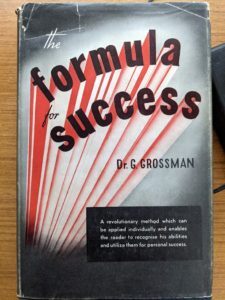 My Dad’s copy of “The Formula for Success”
My Dad’s copy of “The Formula for Success”Since my mid-twenties, I’ve had a thirst for knowledge and for the past few years have regularly read 30+ books each year.
Many of the books I read are what would be described as being from the “Self Development”, or “Self Help” genre.
Growing up, I saw that my Dad had a fondness for reading books, but never really paid attention to the books he collected in his library.
That changed when I visited Birmingham recently and stayed with my Mom in my childhood home.
Mom had left Dad’s library of books in his old room, and so I decided to take a closer look at them.
To my surprise, despite the age of the books, there were a large number of books on self improvement.
One such book caught my eye — The Formula For Success by Dr. Gustav Grossman, published in 1957.
The book describes itself as “A revolutionary method which can be applied individually and enables the reader to recognise his abilities and utilise them for personal success.”
A Handwritten Note from My Dad My Dad’s notes on The Formula For Success by Dr Gustav Grossmann
My Dad’s notes on The Formula For Success by Dr Gustav GrossmannIntrigued, I picked the book up to read it and when I opened it, a handwritten note from my Dad fell out of the book!
As you can see, Dad’s notes included thoughts on:-
The lack of target is the chief reason for the lack of successYou must find your purpose yourselfIf you recollect your early childhood, you will find there in miniature that which your heart still desires todayHe who has no purpose would be well advised to acquire oneBy imitating the bodily expressions of various moods, I can act myself into those moodsEverybody lets himself be influenced to his advantage.I will freely admit that I was shocked to find this note from Dad, as I’d never once considered that he and I had shared an interest in the same area of self development.
When I showed the note to my Mom, she told me that Dad was always reading such books to learn how to improve himself.
I must admit, I become very emotional realising that, some eleven years after his passing, my Dad and I shared a passion that I never knew about when he was alive.
Since then, I’ve sat down to read “The Formula for Success” book and to absorb some lessons from my father.

 Dr Gustav Grossmann (1970)
Dr Gustav Grossmann (1970)The book “The Formula For Success” was written in 1957 by Dr. Gustav Grossmann.
I’ve since researched Dr. Grossmann, and found that he was a German psychologist and writer.
Dr Grossmann created a pschotechnology methodology for rationalisation called “The Grossmann Method”
During the first world war, Dr Grossmann sustained severe war injuries.
As a result of his injuries, Dr Grossmann was prompted to develop a system for “self-realisation” and performance improvement.
Despite Dr Grossmann’s passing in 1978, interest in his “Grossmann Method” continues to this day, with a website, Facebook page and community of fans.
The copy of “The Formula for Success” that Dad acquired had been translated from the original German into English language.
Being written in 1957, some of the language that Grossmann uses in his book may seem dated by modern standards, but many of the lessons within the book are, in my opinion, evergreen.
As a result, I thought I might share three of the key lessons from my father that Dad highlighted in his notes about the book.
Lessons from My Father – Your Early Childhood Influence on Present Day DesiresWhen I read my Dad’s handwritten note on “If you recollect your early childhood, you will find there in miniature that which your heart still desires today“, I was immediately struck by the sentiment for me, personally.
This is a lesson from my father that I could not have realised until later in my life.
When I was about 8 or 9 years old, Mom and Dad saw my interest in computers.
As a result, they bought me a second-hand Atari 600XL computer (you can read more in my article on Remembering My First Computer).
My parents, and schoolteachers, encouraged my interest in computers.
As a result, in my thirties, I built and sold a Birmingham-based IT Managed Service Provider (MSP) business.
To this day, I’m fascinated with technology and the application of computing in our everyday lives.
I sometimes wonder where I’d be, if Mom and Dad hadn’t encouraged my love of computers when I was younger.

As I’ve become older, another passion I’ve maintained is a love of retro computing.
I’ve collected the Atari’s, Commodore’s, Spectrum and BBC Micro’s that I knew as a child. I now enjoy them as a hobby as an adult.
 The wildlife pond we’ve had created in our back garden. As a child, I was always fascinated with pond life.
The wildlife pond we’ve had created in our back garden. As a child, I was always fascinated with pond life.Geeky? Absolutely! But I think there is a lesson from my father here within my Dad’s note on Grossmann’s philosophy.
Can you think of any childhood interests that you might revisit?
Perhaps there is some way you could re-engage with them to increase your present happiness?
For instance, we recently had a makeover of the back garden at our home in Killingworth, Newcastle-upon-Tyne.
As a child, I was always interest in wildlife and, specifically, the wee beasties that lived in ponds.
So, I asked the garden designers if they’d incorporate a wild pond into our new back garden.
Since it has been finished, our new pond has already attracted a newt, frogs, toads and other wildlife. I’ve enjoyed many hours sitting in the garden relaxing in an arbour by the pond.
Therefore, my question to you would be this. What passions did you have in early childhood that you may have forgotten about?
Do you think you could you re-ignite those passions again now?
Lessons from My Father – Imitate Moods To Act Yourself Into ThemI was very intrigued to read Dad’s note on “By imitating the bodily expressions of various moods, I can act myself into those moods“.
This lesson from my father struck a chord with me.
I have been quite open about my own mental health challenges. I’ve experienced episodes of clinical depression which have impacted those around me.
Therefore, I have become passionate about raising awareness of mental health for business owners.
As a result, I’ve created a page with Mental Health Resources for MSP Business Owners and written a book called The IT Business Owner’s Survival Guide that helps IT business owner’s manage their stress levels.
What struck me about Dad’s note is something that I’ve been learning recently. I’ve heard, from various sources, about changing your state of being.
In short, if you’re in a poor mood, then ask yourself. What are the actions you could you take to shake your body and mind into a better place?

For example, music is a powerful impactor on our moods, and thanks to my friend Grace Marshall and her article What’s on Your Pick Me Up Playlist?, I’ve now got a list of music that I can play to help improve my mood.
“Alexa, play my ‘pick me up playlist'” is a frictionless way for me to shift my perspective.
While Amazon Echo wasn’t around when my Dad was alive, I think this is a lesson from my father that is applicable in any age!
Trampoline Your Way To Happiness!

I’ve also purchased a Mini Trampoline for our back garden.
Trust me when I say that it’s *really* difficult to be in a bad mood after a short-time bouncing up and down on a trampoline! 
While my neighbours probably think I’m yampy (A Birmingham term for a “foolish person”) it never fails to shake my body and mind up!
As a result, I’ve bought mini trampolines for friends. Once my friends have overcome looking like an idiot, they have enjoyed bouncing their way to happiness.
Therefore, the next time you’re feeling low, angry, sad or hopeless, ask yourself. What could you do to imitate moods as a way to act yourself into them?

When Dad’s note fell out of the book, the very first thing that struck me was his note on “You Must Find Your Purpose Yourself“.
I feel like this was an important life lesson from my father.
So many of us do things because we think we should.
As a result, many of us spend time doing things that don’t make us happy, or, indeed, fulfil us.
For instance, I mentioned earlier that Dad’s passing was the catalyst for me selling my IT business. I then became an author and speaker.
My purpose in life for the past few years has been to help IT business owners. I want to help them to avoid the mistakes that I made.
Reminding Yourself of Your Purpose I’ve found this purpose to be very fulfilling, but sometimes it’s easy to lose sight of that purpose.
I’ve found this purpose to be very fulfilling, but sometimes it’s easy to lose sight of that purpose.
As I’ve become busier and more in-demand, there are times that I’ve become disillusioned. I have sometimes felt as though I couldn’t meet all my obligations.
This is where reminding myself of the impact of my purpose has been effective.
Some of you may know that I’m a great believer in journalling (you can hear me talk more about this on my Podcast interview with Chris Ducker “How to Journal for Business Growth“.)
Each day I write down (at least!) three awesome things that have happened that day.
Often, those three things I write down will include positive feedback. They will include kind words that have been shared with me by people who have read my books. Or perhaps people have seen me speak, or otherwise been impacted by my work.

 My Jar of Awesome, or “Lucky Diary” as it was called in 1957
My Jar of Awesome, or “Lucky Diary” as it was called in 1957To build upon this, a few years ago, my good friend Polly Brennan encouraged me to create a Jar of Awesome.
Now, every time I get some amazing feedback, I write it on a paper note. I then pop that note into the jar.
As a result, anytime I need reminding of my purpose, I read some notes from my Jar of Awesome!
Interestingly, Dr Grossmann refers to a similar concept in his book, The Formula For Success.
Grossmann refers to this concept as a “Lucky Diary“, where people record happy experiences in a diary on a daily basis.
The goal is to achieve a positive point of view and strengthen positive feelings. In doing so, you remind yourself of your purpose in life.
It seems that, despite being written in 1957, many of the ideas from Dr. Grossmann’s book are still very relevant today!
Conclusion – Lesson from my fatherFinding my Dad’s handwritten note in the 1957 book by Dr. Gustav Grossmann’s “The Formula for Success” was a surprise for me on many levels.
Firstly, it revealed a side of my Dad’s nature and interests that I wasn’t aware of.
It seems both my Dad and I shared a lifelong passion for improving ourselves.
Secondly, many of the lessons my father took from this 1950’s book are still very relevant today.
You must have a purpose in life (and remind yourself often of what it is)It is possible to (in some cases, literally!) shake yourself out of low moods. By doing so, you can shift your mind and body in into a better placeRemembering childhood passions, and revisiting them, can help bring greater happiness in the present dayThank you for allowing me to share this personal topic with you. I hope you’ve found my insights (or should I say, top life lessons from my father!) useful.
I’d love to hear your thoughts. Please feel free to leave a comment below or get in touch.

The post The Formula For Success – Top Life Lessons From My Father appeared first on Richard Tubb.








